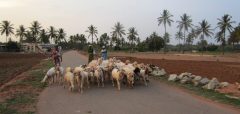This post concludes the series – Voices from the Margins.
The exclusive sign of success in a society steadfast in growth-centric development and urban centric growth appears to be one’s distance from soil. Family farms (farms run mostly by family labour) in India present a dismal picture with worsening cash flow both to and from them. The only surviving ones are either farmers close to big cities, growing exotic crops or animals or rural farms with reliable non-farm income. Nevertheless, as rural non-farm livelihoods like those from forest produce, arts, crafts, weaving, leather and metal works vanish in the glitz and glamour of globally connected industrial production, family farms emerge as the universal eco-cultural livelihood of Indian villages.
Village commons are crucial for small holders to survive, graze livestock and maintain soil fertility. Increasing privatization of commons for powerful organizational entities (than distributed either to the landless or to those displaced by dams, wildlife sanctuaries, airports, express ways, industrial estates or special economic zones), constrain the cash strapped family farms. Thus whether rain-fed or irrigated, rural landscapes witness an exodus of its people – either seasonally or for good. Those who continue in the production landscapes, more often than not, struggle in distress.

Though urban India constantly encounters these farmer migrants as casual labour, it neither notices nor recognizes them as producers. Only if land could speak, it could tell the story of how our society knowingly and unknowingly is engaged in cleansing the last ecocultural livelihood of millions. Why else do we pitch food policies and farm policies against each other? Can consumer priorities be against or away from the interest of family farms who are vulnerable consumers themselves? Do we think of these producer –consumers when we hurriedly nod for shipments from distant shores? Spread across diverse agro ecologies, family farms produce anything from coconuts to walnuts; coffee to apples; spices to vegetables; pulses and oilseeds to staples like millets and tubers.
We overlook their potential to provide goods and services at competitive costs. Despite being a functional democracy, we make the goods and services provided by millions of family farms cheaper and those they need costlier. Soaring cost of production, crop loss and price volatility, alongside unaffordable medical expenditure are tearing apart our agrarian economy as the stories in Voices from the Margins portray. Living our lives as exclusive consumers, we are oblivious of the connectedness between our own health, the food we consume and the livelihoods in producing our food. Is it too difficult to see that orchestrating distress in small family farms goes hand in hand with our own ill-fare?

Many believed that as small farm units become unviable, families can move out of rural India towards urban opportunities. Scores of migrant workers in Indian cities prove that it is not a viable move both for them and the city.
Hope? In the era of social networks, revitalizing positive sociocultural institutions for sustaining diverse skills, knowledge, food and agroecology must be an opportunity. Start-ups are not difficult to be founded by sourcing local farm products or employing local human resource without mining natural resources, displacing people or polluting the landscape. A thoughtful and humane society will try to unlearn some of the irrelevant science and economics copy pasted from alien geographies and societies. A decentralized democracy in such a society will try and meaningfully link production and consumption; for instance linking school and hospital feeding programs with local farm products under community monitoring. It will evolve practice, knowledge and governance for integrating societal well-being with livelihoods; offering a lesson or two for others to learn from.

Unless we harness the promise that top soil and agrarian communities together extend, 21st century India will be known for driving to extinction, a potentially vibrant ecology, culture and livelihood called small family farms.
Next set of posts in this blog will be on some practical problems encountered in pursuing the above.
